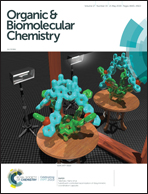New mechanism, new chromophore: investigating the electrophilic behaviour of styrylindolium dyes†
Abstract
To inform the design of future merocyanine-based sensors for nucleophilic analytes, a range of model styrylindolium salts were synthesised, and their behaviour towards cyanide, methanethiolate and sulfide was examined using spectroscopic techniques. In the majority of cases, standard 1,2- and 1,4-nucleophilic additions predominated; however, 4-nitrostyrylindolium salts underwent an unexpected dearomatising 1,8-addition with sulfur-centred nucleophiles. The enamine triene products thus produced display useful optical properties and provide a platform for novel sensor design, and the unusual 1,8-reaction pathway enables synthesis of novel molecular architecture.



 Please wait while we load your content...
Please wait while we load your content...